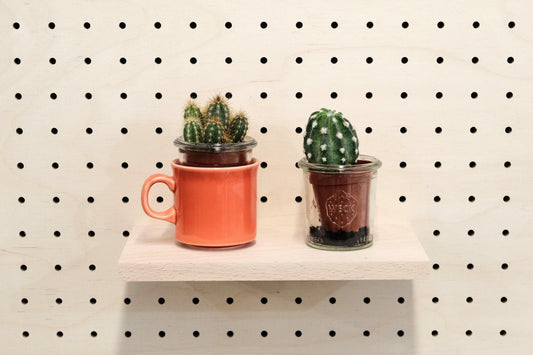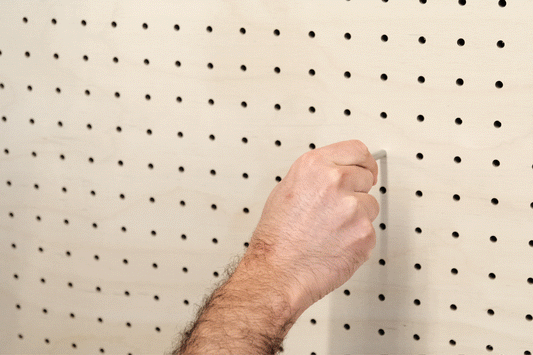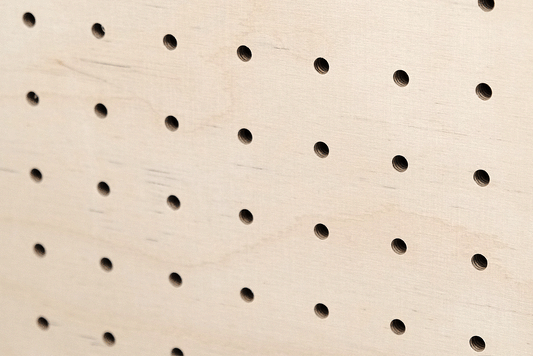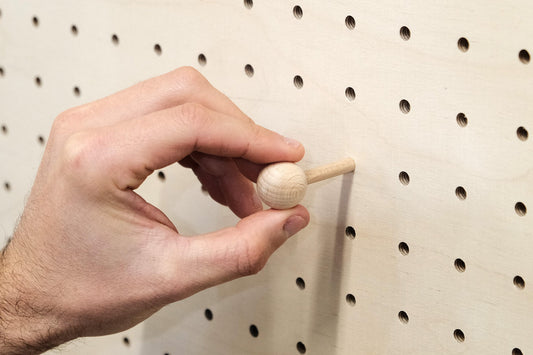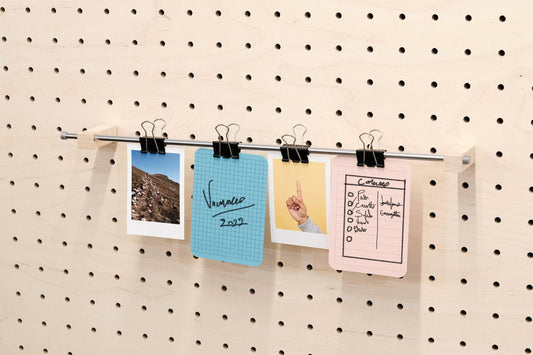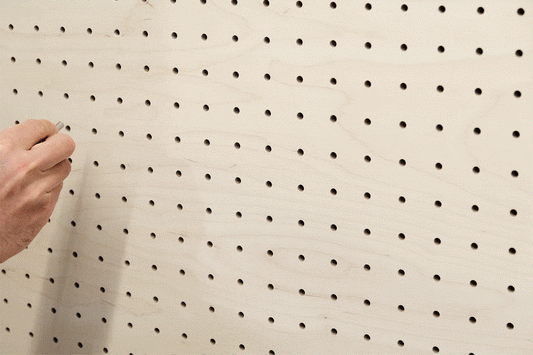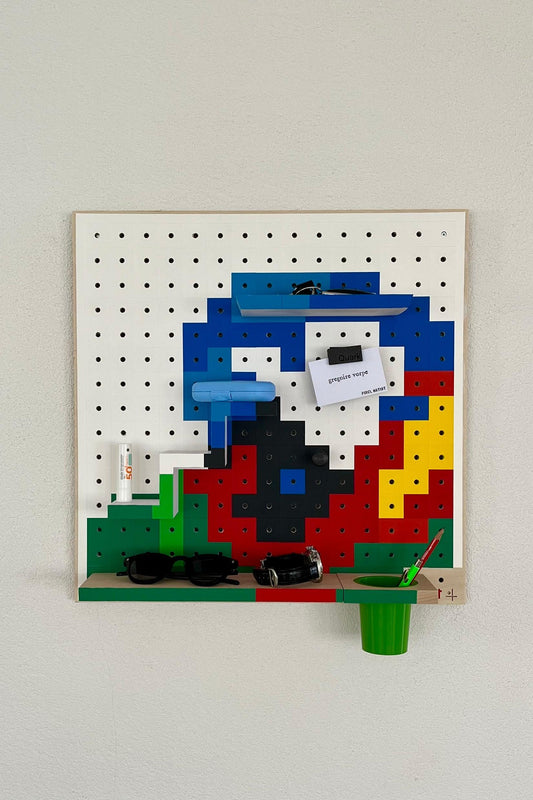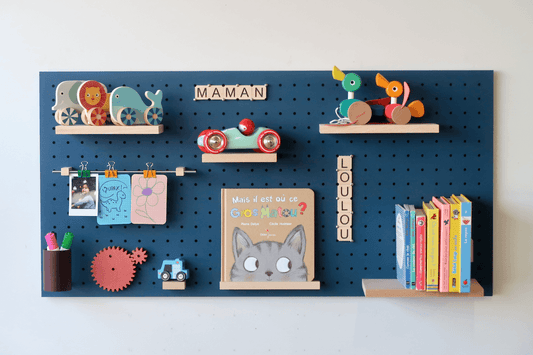Hey, music lovers and decor enthusiasts! Have you ever imagined transforming your space with a unique visual and sound harmony? We will take you on a journey through a universe where the captivating rhythms of exotic instruments combine with the elegance and functionality of perforated panels . It's more than a decoration; it's a celebration of music and style, a visual symphony in your living room. Get ready to explore the beauty of koras from Africa, sitars from India, and more, all beautifully integrated into your home.
World Musical Instruments
Stringed :
Let yourself be carried away by the enchanting melody of the kora. A stringed musical instrument native to West Africa, notably the regions of Senegal, Mali, Guinea and the Gambia. It is an instrument with a captivating and captivating sound, which therefore occupies an important place in the culture and music of these regions. The kora consists of a resonance box in the shape of a half-calabash (a kind of gourd) covered with cow or goat skin, to which several nylon or gut strings are attached. The strings are stretched from the base of the gourd to a wooden bridge at the top of the instrument. This bridge therefore allows you to adjust the pitch of the notes according to the tension of the strings.
Kora player ©Getty - Philippe LissacThe player, called a koriste, plays the kora by plucking the strings with the thumbs and index fingers of both hands. Each string can be tuned differently, creating a range of harmonious notes. The melodies produced by the kora are soft, melancholic and often hypnotic. Evoking the landscapes and emotions of West Africa.
Kora players therefore often use this instrument to accompany traditional songs and stories. Griots, who are storytellers and traveling musicians in Mandinka cultures. They frequently play the kora to tell epic stories, legends and stories of the community. The kora thus plays an essential role in the oral transmission of African history and culture. In addition to its role in oral traditions, the kora has found its place in contemporary music and the world of fusion. Many international artists now integrate the kora into their compositions. Thus creating bridges between musical genres and cultures.
-
The sitar:
Photo: South West Heart
The sitar is emblematic of classical Indian music. This plucked string instrument plays an essential role in Indian music. An instrument that has also influenced artists and music around the world.
It is characterized by its elongated body and its gourd-shaped resonance box. It generally has between 18 and 20 strings. Of these, 6 or 7 main strings are played with the fingers, often using a metal tab called a mezrab. They are accompanied by a series of sympathetic strings that vibrate in response to the notes played. These sympathetic strings therefore contribute to the rich and complex sound of the sitar. Sitar playing involves specific techniques, including plucking, sliding, vibrato, and bending. Sitar players can therefore produce a wide range of sounds. Ranging from captivating melodies to virtuoso and rhythmic ornaments.
The sitar is a solo instrument in Indian classical music. But it can also accompany other instruments and the voice in more complex compositions. Outside of classical music, the sitar has found its place in contemporary musical genres. Such as fusion, jazz and world music.
Its evocative sound and its ability to express a wide variety of emotions therefore make it a particularly appreciated and respected instrument. Both in India and the rest of the world. The sitar continues to charm listeners and enrich world music with its cultural heritage and unique musicality.
Wind:
-
Japanese Shamisen:
Photos: Larousse
Immerse yourself in the delicacy of Japan with the distinctive sounds of the shamisen. A traditional Japanese plucked stringed musical instrument. It is recognized for its distinctive sound and its prominent place in Japanese folk and classical music. This stringed instrument therefore dates back several centuries and continues to occupy an important place in Japanese musical culture.
The shamisen consists of three main parts: the body (do), the handle (sao) and the bridge (koma). The body of the shamisen is usually made of paulownia wood. While the handle is often made of rosewood or ebony. The strings, made of silk or nylon, are stretched along the entire length of the neck, passing over the bridge to attach to the tuning peg at the end of the neck.
Photo: Japan Expedition
Flickr Joi Ito https://creativecommons.org/licenses/by/2.0/deed.fr
Shamisen playing involves plucking the strings using a plectrum called bachi. The sound produced can therefore vary depending on playing technique, hand movements and pressure exerted on the strings. This interaction between the strings and the plectrum gives the shamisen its characteristic sound, both melancholic and powerful.
Shamisen is often associated with traditional Japanese music. Including the kabuki style of music, noh theater and minyō (folk) music. It also accompanies singing and dancing, adding an emotional dimension to the performances.
-
Aboriginal Didgeridoo:

The didgeridoo is a wind musical instrument emblematic of Australian Aboriginal culture. It is one of the oldest instruments in the world. And so it plays an essential role in the rituals, ceremonies and traditional music of Australian indigenous people.
It is made from a tree trunk hollowed out by termites. It can measure 1 to 3 meters long. Its characteristic shape is that of a slightly conical cylindrical tube. Additionally, the mouth of the instrument is often decorated with artistic designs that reflect the stories and cultural symbols of Aboriginal people.

To play the didgeridoo, the musician blows into the narrow end while achieving a continuous buzzing effect with his lips and throat. This therefore creates a characteristic resonance which can be modulated by adjusting the position of the tongue and the force of the breath. The sounds produced by the didgeridoo are deep, vibrant and captivating. They often evoke the sounds of nature, such as wind, birds and wild animals.
The didgeridoo is often used in ritual ceremonies, mythological stories and traditional dances of Aboriginal people. It plays an important role in cultural and spiritual transmission. As well as in creating a connection with the Earth and the ancestors.
Over the years, the didgeridoo also gained popularity outside of Australia and became a world musical instrument. Integrated into various contemporary musical genres. Musicians around the world have explored its unique sounds and incorporated it into modern compositions. Thus creating cultural bridges between ancient traditions and contemporary musical expressions.
Percussion:
-
African Djembe:
The African djembe is an iconic percussion instrument originating from West Africa, and more specifically from countries such as Guinea, Mali, Senegal and Ivory Coast. This traditional hand drum has a rich history and deep cultural significance within African communities.
The djembe is made from a hollowed-out tree trunk and a goat or cow skin stretched over the upper part. The base of the drum is wider and the upper part becomes thinner, giving it a chalice shape. The skin is stretched by braided ropes which allow the tension to be adjusted to obtain different tones.

In West Africa, the djembe is often played in groups during ceremonies, community gatherings and festivities. It occupies a central place in the music, dance and culture of these regions. Djembes are often used to accompany singers, dancers and other traditional instruments.
In addition to its role in celebrations and rituals, the djembe also has important social and cultural significance. It is considered a means of communication between individuals and generations. They therefore allow stories, values and messages to be transmitted within the community. The rhythms and melodies played on the djembe can express a range of emotions, from joy to sadness, from celebration to meditation.
Nowadays, the djembe has found its way beyond the borders of Africa, becoming popular around the world. It is performed at concerts, festivals and even in music and dance classes in many countries. World music fans appreciate the depth of djembe sounds and the cultural connection it can provide.
-
Peruvian Cajón:

Immerse yourself in the festive atmosphere of Latin America with the infectious rhythm of the Peruvian cajón. The cajón is a percussion instrument of Peruvian origin that has gained international popularity for its unique sound and versatile role in various musical genres. “Cajón” literally means “crate” or “box” in Spanish. This is precisely the characteristic shape of this instrument.
It is generally made from thick, durable wood, with a body in the shape of a rectangular parallelepiped and a striking surface (the upper side) of thinner wood. At the back, an opening allows sound to be projected. The musician sits on the cajón and strikes the striking surface with his hands, fingers and palms, producing a variety of sounds and rhythms.

Originally, the cajón was used in Afro-Peruvian communities during celebrations and parties. This instrument was made from salvaged wooden boxes and used to produce catchy rhythms that accompanied dancing and singing
The cajón has also been adopted by many other musical genres around the world. It became an instrument of choice in Spanish flamenco, where it was integrated into traditional ensembles to accompany singing and dancing. Additionally, the cajón has also found a place in contemporary music, including jazz, rock, pop music, and even electronic music.
Today, the cajón is not only used as a rhythm instrument, but it is also often considered a work of art in its own right, with artistic designs and ornaments. Its versatility and rich history make it a symbol of the musical diversity of Peru and around the world.
The Universal Power of Music

The impact of music on all cultures
Music is a universal language that transcends cultural and linguistic barriers. Indeed, it has the unique power to touch hearts and tell stories, regardless of location and origin. Over the centuries, each culture has developed its own melody, its own rhythm and its own instruments. Creating a richness of sound that resonates around the world. Traditional music therefore offers privileged access to the soul of a culture, revealing its deep emotions, its beliefs and its way of seeing the world.
Music as a language transcending borders
She is a bridge between people and nations, creating an emotional connection across differences. Indeed, traditional melodies have the power to revive ancient stories, evoke memories and establish mutual understanding between cultures. On the other hand, notes and rhythms remind us of our common humanity and reinforce our sense of belonging to a vast global community. Music transcends geographic and linguistic boundaries, allowing everyone to find a place of expression, sharing and exchange.

Across continents and cultures, music remains a common thread that connects us to each other. Above all, it reminds us that our human experiences are deeply connected and that our emotions are universal. So immerse yourself in this musical mosaic, discover the stories that each note tells, and let yourself be carried away by the universal language of music that unites hearts and souls.
This musical journey reminds us of the depth and beauty of the traditional music that surrounds us. Therefore, by exploring the sounds, stories and emotions of different cultures through their melodies, we have opened a window to a world rich in history and diversity. I encourage you to continue exploring the musical treasures of different regions of the world, whether by listening to authentic recordings, attending live performances, or even learning to play some of these fascinating instruments.
I hope you enjoyed this blog post! Don’t hesitate to share other instruments with us in comments 🎶
See you next week 👋

















